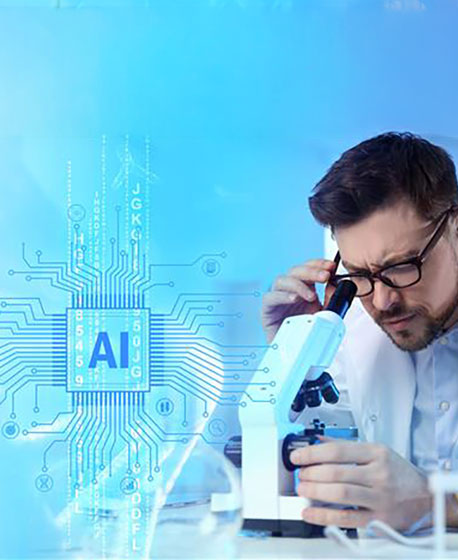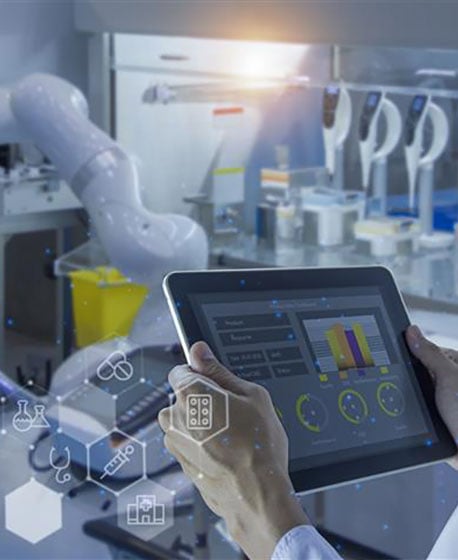-

 At Cyient, We
At Cyient, We
Embrace Intelligence
- Human & ArtificialA point of view by Sukamal Banerjee,
Executive Director and Chief Executive Officer,
Cyient
The challenge that comes with being “AI-first”
Scroll through your feed, attend any conference, or scan the headlines and one narrative seems to dominate. From startups to global service providers, so many organizations describe themselves as “AI-first.”
It’s become the defining mantra of the moment – a signal of ambition, but also a symptom of consensus. The industry appears united behind the same idea: that leadership in the future will belong to those who see and embrace AI-first.
Yet in practice, few stop to question what “AI-first” really means – or whether it’s meaningful or even possible to be AI-first.
“AI-first” has become the corporate equivalent of background noise – a statement of aspiration that speaks little of competence, context, or responsibility. It’s a posture, not a position. It suggests conformance, but not necessarily direction.
At Cyient, we have consciously decided not to join that chorus. Not because we underestimate the power of AI – far from it. We build, deploy, and embrace AI in thousands of real-world applications every day. But we’ve chosen to make a deliberate, conscious distinction between mindfully adopting AI and being defined by it.
Why we’re choosing a different path
When markets rush toward a single narrative, it’s often a sign that clarity has been displaced by a desire for conformity. We’ve chosen to think beyond the trend, to ask the harder question: what happens after everyone becomes AI-first?
The answer is simple: you still need engineers. You still need systems that work. You still need domain intelligence – the kind built over decades of solving complex problems in aerospace, energy and utilities, telecom, healthcare, and manufacturing.
Our conviction is simple: intelligence should be embraced – in all its forms.
We believe that what matters is ‘intelligence’, whether that’s human or artificial. In some cases, it’s one or the other; in many cases, the most powerful outcomes arise when it is both.
This belief underpins our commitment to the continuous development of Intelligent Engineering, where we start with human expertise and deep domain knowledge – codified in competency libraries and domain standards – and leverage AI as an amplifier.
But AI does not determine our thinking. It supports it, helping us to test assumptions, reimagine, challenge and sharpen the way we think and operate. Yes, AI can replace and eliminate well-defined, repeatable tasks; it can change the needs for certain workflows and processes, it can help us to identify insights faster from a mountain of literature (although only when humans can frame the right prompt); but it cannot replace the need for engineering, nor change the laws of physics that govern the physical world of products. It cannot contextualize for safety critical systems, and their design and deployment processes.
Hence, the real opportunity lies not through being AI-first, but in the convergence of human intelligence, domain expertise and artificial intelligence. This approach is not contrarian for the sake of it. It’s a question of relevancy, responsibility and longevity.
This is why Embracing Intelligence matters most to us.
Hype cycles and hierarchy
If we look back, there’s a clear pattern to every major technological shift. When a new capability arrives, it gets labelled as a revolution – businesses race to be first to adopt, and in that rush, the hierarchy of value gets inverted. The tool becomes the headline.
But technology has never created lasting advantage by itself. Advantage comes from how one adopts it – where, why, and to what end.
AI will be no exception.
When we treat AI as ideology rather than instrument, albeit a powerful one, we risk losing sight of the human intelligence that make it meaningful. Inverting the hierarchy – putting the tool before the purpose – may create impressive demos and POCs, but not enduring outcomes.
This is not about being cautious. It’s about being clear.
Being “first” is rarely the same as being right. The companies that endure are those that apply intelligence contextually, responsibly, and with a depth of understanding.
Embracing Intelligence for Engineering
Our business has always been grounded in engineering. This is not just about what we do – it’s how we think. We build and support systems that work in the physical world: networks, assets, aircraft, turbines, sensors, satellites. In these environments you can’t simply “move fast and break things.” You must move purposefully and make things that last.
That’s why we are drawn to the principle of engineering that embraces intelligence, rather than the promotion of artificial intelligence.
Engineering that embraces intelligence is the integration of three things:
- Human expertise - which includes judgement, creativity, and ethical awareness.
- Domain knowledge – which provides understanding of context, constraints, and design logic.
- Artificial intelligence – which introduces the computational power to accelerate insight and execution.
AI becomes truly powerful only when it’s embraced and embedded in systems designed by people who understand the domain. In aerospace, that means optimizing maintenance schedules without compromising safety. In energy, it means designing predictive models that reduce waste and emissions. In telecom, it means creating self-healing networks that learn from real-world usage patterns.
Each of these examples depends not on “AI-first” thinking, but on Embraced Intelligence which enables AI to be applied ‘in context’, precisely where it makes systems more resilient, sustainable, and human-centric.
A question of responsibility
There’s also an ethical dimension to this choice.
AI is extraordinary – but it is not neutral. The way we design, train, and deploy it reflects our values. Declaring ourselves “AI-first” would imply that technology leads our thinking. It doesn’t. People do.
As engineers, we have a responsibility to ensure that the systems we build are transparent, fair, and sustainable. That means applying AI thoughtfully, not universally; responsibly, not reactively.
It’s easy to automate. It’s harder to design automation that improves human lives.
This is not about limiting what AI can achieve. It’s about ensuring that what AI achieves is grounded in the realities of the world it operates in – and the people it serves.
We believe that intelligence must serve expertise, and progress must serve purpose.
Closing reflection: A different kind of leadership
Choosing not to be “AI-first” doesn’t mean standing still. It means leading differently.
It means being clear about what defines you and what doesn’t. It means rejecting shortcuts to relevance. It means trusting your fundamentals more than the noise of the market.
Leadership, in this sense, is not about following the latest trend or making the most noise; it’s about setting the tone for sustainable progress.
For us, this tone is one of calm conviction:
- That technology should serve expertise, not replace it.
- That intelligence should be embraced, not biased or declared.
- That being contextual & intuitive is the highest form of innovation.
At Cyient, our position regarding AI is not one of resistance, it’s one of responsibility for the way we embrace intelligence.
Artificial intelligence will continue to evolve, and throughout this evolution, the way we embrace intelligence - human, domain, and ethical - will always come first.
Leading the AI-Powered Evolution in Healthcare
At Cyient, we’re helping healthcare and life sciences organizations move from digital to intelligent, where AI amplifies human ingenuity and engineering precision. By combining deep domain expertise with advanced technology and data science, we turn algorithms into insights, and insights into measurable impact.
This is how being Domain-First, Tech-Driven, and AI-Infused creates enduring differentiation.

AI-Driven
Product Design
Embedding intelligence into device design and validation to enhance performance and reliability.

Smart
Manufacturing
Applying predictive analytics to boost quality, minimize downtime, and optimize throughput.

Connected
Health Ecosystems
Integrating AI, IoT, and edge computing to power real-time insights and personalized care.

Regulatory &
Quality Intelligence
Automating compliance, documentation, and risk management with AI precision.

Lifecycle
Intelligence
Using digital twins and predictive models to extend product life and accelerate innovation.
.png?width=774&height=812&name=Master%20final%201%20(1).png)